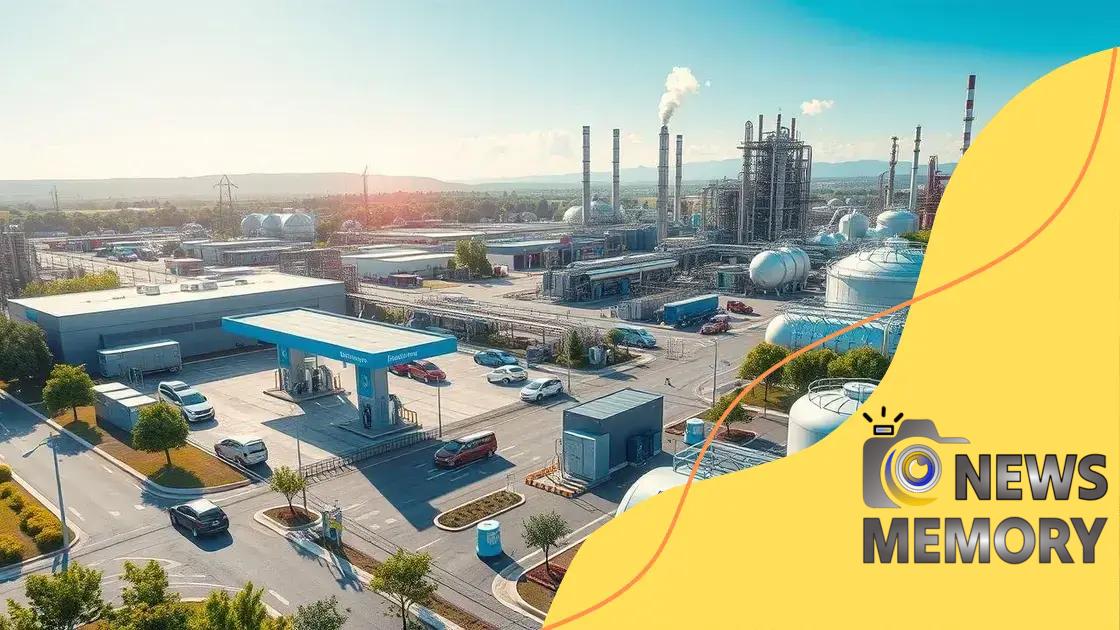Advances in clean hydrogen energy technologies for a sustainable future

Advances in clean hydrogen energy technologies offer a sustainable solution for reducing carbon emissions, with significant investments and innovations enhancing production efficiency and infrastructure development.
Advances in clean hydrogen energy technologies are shaping the future of sustainable energy. With increasing global energy demands, hydrogen energy presents an exciting opportunity. Have you considered how hydrogen can revolutionize energy systems?
Understanding clean hydrogen energy
Understanding clean hydrogen energy is essential as we seek sustainable alternatives to fossil fuels. This energy source has enormous potential to change our energy landscape. Using hydrogen can decrease carbon emissions significantly, making it a crucial part of a greener future.
The Basics of Hydrogen Energy
Hydrogen is the most abundant element in the universe. It can be produced from various resources, including water, natural gas, and biomass. When used as fuel, it generates electricity with water as the only byproduct. This characteristic makes hydrogen a clean energy option that aligns with our environmental goals.
Methods of Hydrogen Production
There are several key methods to produce clean hydrogen:
- Electrolysis, which splits water into hydrogen and oxygen using electricity.
- Steam methane reforming (SMR), which extracts hydrogen from natural gas.
- Gasification of biomass, which turns organic materials into hydrogen-rich gas.
Among these methods, electrolysis stands out as it can use renewable energy sources, making it a promising route for the future. As technology advances, the cost of producing hydrogen is expected to decrease, further enhancing its viability.
Moreover, hydrogen can be stored and transported easily, making it versatile. It can power vehicles, heat buildings, and even serve as an industrial feedstock. Its adaptability is one reason why governments and companies worldwide are investing in hydrogen technologies.
Benefits of Clean Hydrogen Energy
There are numerous benefits associated with adopting clean hydrogen energy:
- Reduction in greenhouse gas emissions.
- Diverse applications across multiple sectors.
- Potential for energy independence.
As we continue to explore this energy source, it’s important to note the challenges we face. These include production costs and infrastructure development. However, as research progresses, solutions to these challenges will emerge, paving the way for broader acceptance of hydrogen.
Recent technological breakthroughs
Recent technological breakthroughs in clean hydrogen energy are transforming the landscape of renewable energy. These advancements are making hydrogen production more efficient and accessible. With innovative technologies, the potential for hydrogen to power our future is growing rapidly.
Advances in Electrolysis
Electrolysis technology has seen significant improvements, allowing for more efficient hydrogen production. Modern electrolyzers can use renewable energy sources like wind and solar, making the process greener. The efficiency of these systems has increased, resulting in lower costs for hydrogen production.
Improved Hydrogen Storage Solutions
Alongside production, advancements in hydrogen storage are crucial. New materials and methods are being developed to store hydrogen safely and economically. Some of these methods include:
- Metal hydrides, which can absorb hydrogen gas and release it when needed.
- Advanced composites that offer lightweight and efficient storage options.
- Cryogenic storage techniques that keep hydrogen at very low temperatures.
These technologies enhance the reliability and feasibility of using hydrogen fuel widely, contributing to its role in a sustainable energy future.
Fuel Cell Innovations
Fuel cells, which convert hydrogen into electricity, are experiencing groundbreaking innovations. Recent designs focus on improving power density and reducing costs. Enhanced materials are making fuel cells more durable and effective in various applications. These improvements lead to wider adoption of fuel cell technology in vehicles, homes, and industries.
Moreover, integrating fuel cells with renewable energy systems allows for better energy management. The combination enhances efficiency and ensures that excess renewable energy can be stored and used later, minimizing waste.
As researchers continue to uncover new methods and materials, the clean hydrogen sector is poised for rapid growth. With ongoing support from governments and private sectors, the transition to a hydrogen economy is becoming increasingly viable.
Applications of hydrogen in various industries

Applications of hydrogen in various industries showcase its versatility and potential as a clean energy source. From transportation to manufacturing, hydrogen plays a crucial role in reducing carbon footprints. Many sectors are increasingly adopting hydrogen technologies to enhance their sustainability efforts.
Transportation Sector
In the transportation industry, hydrogen fuel cells are gaining popularity. They provide a clean alternative to traditional gasoline and diesel engines. Hydrogen-powered vehicles emit only water vapor, making them an environmentally friendly option. The technology is not limited to cars; it also includes buses and trucks. As charging infrastructure improves, many cities are investing in hydrogen refueling stations.
Industrial Uses
Hydrogen is extensively used in various industrial processes:
- In the production of ammonia for fertilizers.
- As a reducing agent in metal processing, especially in steel manufacturing.
- In petroleum refining, where it helps remove impurities.
These applications are vital for improving efficiency and reducing emissions in industrial settings.
Energy Storage and Grid Management
Hydrogen also serves as an effective solution for energy storage. It allows for the excess energy generated from renewable sources to be stored and used later, making energy management more efficient. For example, during periods of high energy production from wind or solar, excess energy can be converted into hydrogen. This stored hydrogen can then be utilized when energy demand is higher, ensuring a constant supply.
This process helps balance the energy grid, making it more resilient and reliable. As more renewable energy projects come online, hydrogen will become a key player in stabilizing energy supplies.
With these diverse applications, the future of hydrogen in various industries looks promising. Continued investment and innovation will only expand its role in creating a sustainable world.
Challenges in hydrogen production
Challenges in hydrogen production are crucial to understand as we push for greater adoption of this clean energy source. While hydrogen holds tremendous promise, several obstacles must be addressed to make it a mainstream energy solution. These challenges include technology, cost, and infrastructure limitations.
High Production Costs
One primary challenge is the high cost associated with hydrogen production. Current methods like steam methane reforming and electrolysis can be expensive. The prices for renewable energy inputs, particularly solar and wind, influence the total cost of producing hydrogen through electrolysis. If these costs remain high, hydrogen may not be competitive with fossil fuels.
Infrastructure Requirements
Another significant obstacle is the lack of infrastructure for hydrogen distribution. To make hydrogen widely available, extensive pipelines and refueling stations are necessary. Developing this infrastructure requires substantial investment and commitment from various stakeholders, including government and private sectors. Without a comprehensive network, even the best hydrogen technologies may fall short.
Energy Efficiency and Emissions
Concerns about the overall energy efficiency of hydrogen production processes also pose challenges. While hydrogen combustion produces no carbon emissions, the methods of production can result in significant greenhouse gas emissions. Transitioning to greener production methods is essential to capitalize on hydrogen’s full potential as a clean energy source.
As hydrogen production technologies evolve, researchers are actively seeking solutions to these challenges. From enhancing the efficiency of electrolyzers to establishing effective distribution networks, the focus is on making hydrogen a viable alternative in the energy market.
Efforts to lower production costs and develop infrastructure are crucial steps in advancing hydrogen as a mainstream energy resource. With continued innovation and investment, many believe that these challenges can be overcome.
Future prospects for hydrogen energy
Future prospects for hydrogen energy look bright as industries and governments focus on sustainable solutions. This clean energy source has the potential to reshape the energy landscape. With advancements in technology and increased investments, hydrogen is set to play a crucial role in reducing carbon emissions across various sectors.
Growing Investments
One major factor influencing the future of hydrogen energy is the rise in investments. Governments and corporations are recognizing hydrogen’s potential as a green fuel. Countries like Japan, Germany, and Canada are setting ambitious goals for hydrogen production and usage. They are funding research and infrastructure development to facilitate this transition.
Technological Innovations
As technology advances, the efficiency of hydrogen production methods is improving. Innovations in electrolysis and storage technologies will make hydrogen production more cost-effective. For example, researchers are developing new materials that can significantly decrease the energy required for electrolysis. Advances in fuel cells are also making them more efficient and affordable.
Moreover, integrating hydrogen with renewable energy sources can enhance energy security. This integration allows for better utilization of excess energy during peak production periods, helping to balance energy demands.
Global Collaborations
International partnerships are driving hydrogen initiatives forward. Countries are collaborating to establish a global hydrogen economy. Projects aimed at developing hydrogen infrastructure are being launched worldwide. These collaborations not only boost research and development but also create jobs and stimulate local economies.
In the transportation sector, hydrogen fuel cell vehicles are becoming more popular. Major automotive companies are investing in hydrogen technology, which can reduce reliance on fossil fuels. Hydrogen’s versatility means it can also be used in aviation and shipping, further expanding its market potential.
With a robust focus on hydrogen energy, the prospects for a clean energy future are becoming more achievable. As challenges are addressed and technology evolves, hydrogen could play a central role in creating a sustainable world.
FAQ – Frequently Asked Questions about Hydrogen Energy
What is hydrogen energy?
Hydrogen energy is a clean energy source that uses hydrogen as fuel, producing only water vapor as a byproduct when burned.
How is hydrogen produced?
Hydrogen can be produced through various methods, including electrolysis, steam methane reforming, and biomass gasification.
What are the main challenges in hydrogen production?
Challenges include high production costs, lack of infrastructure, and concerns about energy efficiency during production.
What are the future prospects for hydrogen energy?
The future looks promising due to increasing investments, technological advancements, and global collaboration to develop hydrogen infrastructure.





